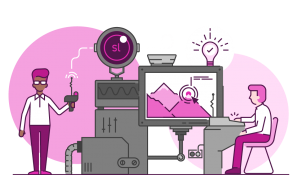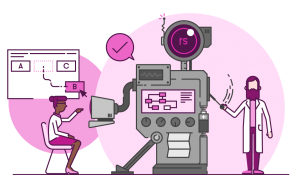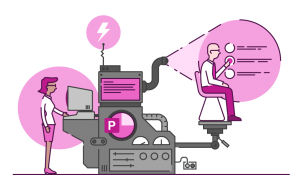Here at BrightCarbon we’re always trying to make eLearning as effective as possible. A few members of the team sat down to talk about lessons from the world of education and the role that interactivity plays in eLearning
Hi everyone! Before we embark on our journey into the world of eLearning, could we have a quick round of introductions?
Ian Hilder: I’ll go first then shall I? Hi, I’m Ian and I do sales and business development, primarily sales but business development which covers marketing and that sort of area.
Mikila Green: Hi, I’m Mikila and I am communication consultant at BrightCarbon. My role involves drawing out the story of a presentation in a visual and compelling way.
Joby Blume: And I’m Joby and I do a bit of everything.
So we’re just going to talk about interactivity in learning, looking at when it works well and when it works badly and how we understand interactivity within the context of eLearning. Can anyone think of a time where they experienced really successful use of interaction in a classroom or a conference or even a lecture?
Mikila: In my past life as a science teacher, I used a lot of group interaction in the classroom. Things that are quite effective, especially when thinking about eLearning, are short timed activities at the start of a lesson or partway through to consolidate a topic. So there could be cards for a group to sort, a puzzle for them to solve…just nice little short, timed activities.
Joby: In a way, a starting point would be to define what we mean by interactivity. I think the best example of interactivity from my education was the tutorial system at Oxford. There you are, you read out an essay and Professor Whoever asks you questions and you have to answer and then they ask you more questions…and that’s unbelievably effective for education. But of course impossible to replicate in eLearning, until machine learning takes off and artificial intelligence and all that stuff.
Probably easier to replicate, was a strategy lesson in my MBA where the guy teaching us had videoed interviews with a company at different times in their development and just kept asking us “What do you think will happen next?” That was so effective because there was a story, and you didn’t know what would happen next and you wanted to know. So you were assessing their strategy but you were also captivated, which is pretty rare in education.
Ian: The first thing I thought of was very simple, at a sort of seminar in a work environment where the guy was making various points about work ethics. But the way he presented it all was through these conundrums. And it got everyone talking, some of it was quite amusing but there was that whole discussion element. So like what Joby touched on, the interactivity was being able to build off each other and there was no ‘right’ or ‘wrong’ answer.
Joby: Which of course is the hardest kind of interactivity to build in eLearning.
Ian: There’s the challenge! How to replicate something like that given that the majority of eLearning out there is quite stand-alone, on-demand stuff.
We have these differences between a classroom environment and an eLearning environment. What are the differences between how and why we use interactivity in those different contexts?
Joby: Well, why do you interact? You get people to interact because you think you will achieve your learning objectives more successfully. So that’s about attention levels, or learning from each other, or practicing a skill that you can’t acquire from watching: the challenge with eLearning is that you can’t interact in as many ways as in real life. So it’s harder but what you’re trying to do is the same.
Mikila: Also, interactivity in school is mainly about group work, but the negative with that is that there could be a leader who is coming up with all the ideas and quite a few people sitting back and letting them do all the work. So you might have half the group that isn’t quite learning anything!
Joby: And there’s some great research out there showing that people who know more don’t contribute! You get all types of people who just won’t say anything.
Mikila: And eLearning is good because it is down to the individual: it’s their marks and they can’t rely on other people’s knowledge. It’s about what they know.
Joby: But isn’t another reason that teachers use interaction in a classroom, is that at certain ages people aren’t geared up for half an hour of just watching a lecture?
Although, we do sit at computers for hours and watch TED talks and things like that…so do we sometimes rely on interactivity because the content isn’t good or interesting enough?
I guess there’s a question about whether the interactions are just there to keep people interested or actually there to help them to learn?
Ian: There is a value to having interactivity to maintain attention levels, but yeah that has to be balanced against just putting interactivity in for the sake of it. Joby makes the good point that if content is good, compelling and engaging then people will sit and watch it. People sit and watch telly for an awful long time don’t they! So it is that question of when and how to use interactivity in an eLearning environment to add value to the content.
Mikila: I agree, I think it needs to be engaging and have a purpose. You should use interactivity to consolidate the learning and check at stages that the users are meeting the objectives, so it has a purpose as well as breaking up the monotony.
Joby: The problem is how that’s executed. Often you watch a little bit and then have to answer a question, but if that question isn’t pitched right…it’s like those competitions where for legal reasons they have to make it a competition but everyone knows the answer because it’s a question like ‘Which is the animal starting with E?’ And it’s just really irritating!
Whereas if someone asks you a question that’s pitched at the right level, it can be interesting because you’re using the things that you’ve learned. But if the question is too simple I think it can actually be disengaging. (Learn more about effective testing here.)
Ian: I absolutely agree: all too often you see eLearning content with questions pitched at the wrong level. Mostly I suspect because the creators are just using questions to check that you’re paying attention. That just becomes annoying that they’re asking that really obvious question, and it’s just interfering and not making you think. So that’s something to avoid.
So, when designing eLearning how do people go about pitching the content at the right level?
Ian: A classic piece of advice is just knowing your audience. But there is also value in not just saying ‘okay this the information I’m going to throw at you’ but testing the user at the outset to see what their level is, and then using some clever branching in your eLearning software, steering people into different sections based on what they know.
Last question! What kind of advice would you give to people who are worried about using interactivity in eLearning? And what are the key benefits?
Joby: The straightforward thing is that you put in interactivity to keep people engaged. But I think you need to go beyond that and think “How can I use interactions to actually reinforce my learning objectives?” “How can I get people to think, to do, to practice, to apply in ways that simulate what they need to do in real life?” And based on what I’ve seen in a lot of eLearning, that isn’t happening.
So maybe take a step back and go back to first principles, and look at what else is out there. If you look at computer games, you can be running worlds and expanding civilisations within about ten minutes on an app on an iPad. Think about how computer games teach and apply that…within the limits of the technology.
Ian: And alongside that, when you first get started with eLearning and you have this new technology, there’s two things that hit you. Either it’s really scary and you just feel like you don’t know how to use it, or you start thinking “Ooh I can do all these things!” and adding interactive bits in just for the sake of it. So don’t get hung up on the technology, remember it’s just a tool and remember what you actually want to achieve: your learning objectives.
Mikila: One last thing: it’s also really important that interactivity is used to segment the eLearning. Lots of eLearning might have loads and loads of content and then a quiz at the end: people find that really hard. It’s much easier for them if you break it down and make sure they’ve got the hang of each point before moving to the next learning objective. And slowly build up the complexity to keep learners engaged, throughout. That’s really key.
If you’re feeling inspired to create some awesome, interactive eLearning, check out our guide to amazing Articulate Storyline interactions. And get even more inspiration elsewhere on the blog, like in our roundup of some of the best uses of interactive video.
Leave a comment




